Related Research Articles
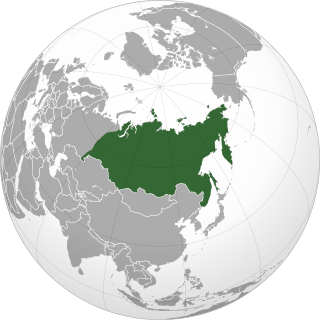
Siberia is an extensive geographical region comprising all of North Asia, from the Ural Mountains in the west to the Pacific Ocean in the east. It has formed part of the sovereign territory of Russia and its predecessor states since the centuries-long conquest of Siberia, which began with the fall of the Khanate of Sibir in the late 16th century and concluded with the annexation of Chukotka in 1778. Siberia is vast and sparsely populated, covering an area of over 13.1 million square kilometres (5,100,000 sq mi), but home to roughly a quarter of Russia's population. Novosibirsk, Krasnoyarsk, and Omsk are the largest cities in the area.
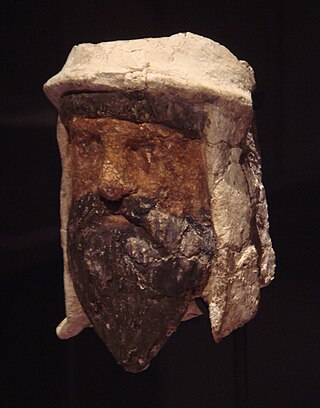
Tajikistan harkens to the Samanid Empire (819–999). The Tajik people came under Russian rule in the 1860s. The Basmachi revolt broke out in the wake of the Russian Revolution of 1917 and was quelled in the early 1920s during the Russian Civil War. In 1924, Tajikistan became an Autonomous Soviet Socialist Republic of the Soviet Union, the Tajik ASSR, within Uzbekistan. In 1929, Tajikistan was made one of the component republics of the Soviet Union – Tajik Soviet Socialist Republic – and it kept that status until gaining independence 1991 after the dissolution of the Soviet Union.
The Uzbeks are a Turkic ethnic group native to the wider Central Asian region, being among the largest Turkic ethnic group in the area. They comprise the majority population of Uzbekistan, next to Kazakh and Karakalpak minorities, and are also minority groups in Afghanistan, Tajikistan, Kyrgyzstan, Kazakhstan, Turkmenistan, Russia, and China. Uzbek diaspora communities also exist in Turkey, Saudi Arabia, United States, Ukraine, and other countries.

The Khanate of Sibir was a Bashkir Khanate in western Siberia, founded at the end of the 15th century, following the break-up of the Golden Horde. Throughout its history, members of the Shaybanid and Taibugid dynasties often contested the rulership over the Khanate between each other; both of these competing tribes were direct patrilineal descendants of Genghis Khan through his eldest son Jochi and Jochi's fifth son Shayban (Shiban). The area of the Khanate had once formed an integral part of the Mongol Empire, and later came under the control of the White Horde and the Golden Horde of 1242–1502.

The Timurid dynasty, self-designated as Gurkani, was a Sunni Muslim dynasty or clan of Turco-Mongol origin descended from the warlord Timur. The word "Gurkani" derives from "Gurkan", a Persianized form of the Mongolian word "Kuragan" meaning "son-in-law". This was an honorific title used by the dynasty as the Timurids were in-laws of the line of Genghis Khan, founder of the Mongol Empire, as Timur had married Saray Mulk Khanum, a direct descendant of Genghis Khan. Members of the Timurid dynasty signaled the Timurid Renaissance, and they were strongly influenced by Persian culture and established two significant empires in history, the Timurid Empire (1370–1507) based in Persia and Central Asia, and the Mughal Empire (1526–1857) based in the Indian subcontinent.

The Ilkhanate or Il-khanate, ruled by the Il-Khans or Ilkhanids, and known to the Mongols as Hülegü Ulus, was a khanate founded by Turco-Mongol conquerors from the southwestern sector of the Mongol Empire. The Ilkhanid realm was officially known as the Land of Iran or simply Iran. It was established after Hülegü, the son of Tolui and grandson of Genghis Khan, inherited the West Asian part of the Mongol Empire after his brother Möngke Khan died in 1259.

The Chagatai Khanate, or Chagatai Ulus was a Mongol and later Turkicized khanate that comprised the lands ruled by Chagatai Khan, second son of Genghis Khan, and his descendants and successors. At its height in the late 13th century the khanate extended from the Amu Darya south of the Aral Sea to the Altai Mountains in the border of modern-day Mongolia and China, roughly corresponding to the area once ruled by the Qara Khitai.
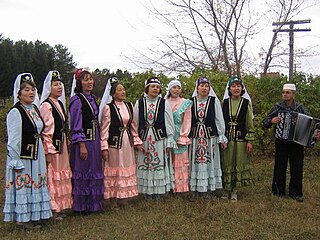
Siberian Tatars or Sibirs/Sybyrs are the indigenous Turkic-speaking population of the forests and steppes of Western Siberia, originating in areas stretching from somewhat east of the Ural Mountains to the Yenisey River in Russia. The Siberian Tatars call themselves Yerle Qalıq, to distinguish themselves from more recent Volga Tatar immigrants to the region.

Berke Khan was a grandson of Genghis Khan from his son Jochi and a Mongol military commander and ruler of the Golden Horde who effectively consolidated the power of the Blue Horde and White Horde from 1257 to 1266. He succeeded his brother Batu Khan of the Blue Horde (West), and was responsible for the first official establishment of Islam in a khanate of the Mongol Empire. Following the Sack of Baghdad by Hulagu Khan, his cousin and head of the Mongol Ilkhanate based in Persia, he allied with the Egyptian Mamluks against Hulagu. Berke also supported Ariq Böke against Kublai in the Toluid Civil War, but did not intervene militarily in the war because he was occupied in his own war against Hulagu and the Ilkhanate.

The Mongol invasions and conquests took place during the 13th and 14th centuries, creating history's largest contiguous empire, the Mongol Empire (1206–1368), which by 1260 covered large parts of Eurasia. Historians regard the Mongol devastation as one of the deadliest episodes in history.

The Uzbek Khanate, also known as the Abulkhair Khanate was a Shaybanid state preceding the Khanate of Bukhara. During the few years it existed, the Uzbek Khanate was the preeminent state in Central Asia, ruling over most of modern-day Uzbekistan, much of Kazakhstan and Turkmenistan, and parts of southern Russia. This is the first state of the Abulkhairids, a branch of the Shaybanids.

The Khanate of Bukhara was an Uzbek state in Central Asia from 1501 to 1785, founded by the Abu'l-Khayrid dynasty, a branch of the Shaybanids. From 1533 to 1540, Bukhara briefly became its capital during the reign of Ubaydallah Khan. The Khanate reached its greatest extent and influence under its penultimate Abu'l-Khayrid ruler, the scholarly Abdullah Khan II.
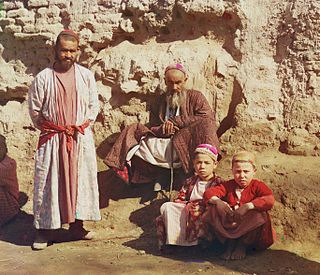
Sart is a name for the settled inhabitants of Central Asia which has had shifting meanings over the centuries.

The Manghud, or Manghit were a Mongol tribe of the Urud-Manghud federation. Manghuds who moved to the Desht-i Qipchaq steppe were Turkified. They established the Nogai Horde in the 14th century and the Manghit dynasty to rule the Emirate of Bukhara in 1785. They took the Islamic title of Emir instead of the title of Khan, since they were not descendants of Genghis Khan and rather based their legitimacy as rulers on Islam. The clan name was used for Mongol vanguards as well. Members of the clan live in several regions of Central Asia and Mongolia.

The history of Islam in China dates back to 1,300 years ago. Currently, Chinese Muslims are a minority group in China, representing between 0.45% to 1.8% of the total population according to the latest estimates. Although Hui Muslims are the most numerous group, the greatest concentration of Chinese Muslims are located in Northwestern China, mostly in the autonomous region of Xinjiang, which holds a significant Uyghur population. Lesser but significant Chinese Muslim populations reside in the regions of Ningxia, Gansu, and Qinghai. Of China's 55 officially recognized minority peoples, ten groups are predominantly Sunnī Muslim.
The Siberian Bukharans are an ethnographic and sociocultural group in Siberia. They constituted a significant part of the Tobol-Irtysh and Tom groups of Siberian Tatars.

The Mongols were highly tolerant of most religions during the early Mongol Empire, and typically sponsored several at the same time. At the time of Genghis Khan in the 13th century, virtually every religion had found converts, from Buddhism to Eastern Christianity and Manichaeanism to Islam. To avoid strife, Genghis Khan set up an institution that ensured complete religious freedom, though he himself was a Tengrist. Under his administration, all religious leaders were exempt from taxation, and from public service. Mongol emperors were known for organizing competitions of religious debates among clerics, and these would draw large audiences.
The division of the Mongol Empire began after Möngke Khan died in 1259 in the siege of Diaoyu Castle with no declared successor, precipitating infighting between members of the Tolui family line for the title of khagan that escalated into the Toluid Civil War. This civil war, along with the Berke–Hulagu war and the subsequent Kaidu–Kublai war, greatly weakened the authority of the great khan over the entirety of the Mongol Empire, and the empire fractured into four khanates: the Golden Horde in Eastern Europe, the Chagatai Khanate in Central Asia, the Ilkhanate in Iran, and the Yuan dynasty in China based in modern-day Beijing – although the Yuan emperors held the nominal title of khagan of the empire.
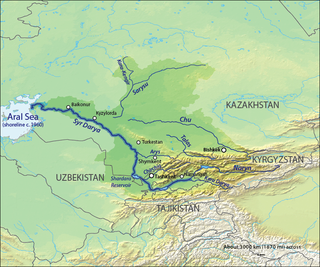
This is a short History of the central steppe, an area roughly equivalent to modern Kazakhstan. Because the history is complex it is mainly an outline and index to the more detailed articles given in the links. It is a companion to History of the western steppe and History of the eastern steppe and is parallel to the History of Kazakhstan and the History of Central Asia.
Shah Murad, also known as Beg-i Jan, alternatively titled Amir al-Mu'minin, Amir Ma'sum Ghazi or Padishah Ghazi in Bukharan historiography, was the first Amir of the Emirate of Bukhara from 1785 to his death in 1799. His father was Ataliq Daniyal Biy (1758–1785). After Daniyal Biy's death, Shah Murad came to power.
References
- ↑ Frank, Allen J. (14 September 2012). Bukhara and the Muslims of Russia: Sufism, Education, and the Paradox of Islamic Prestige. Brill's Inner Asian Library. Brill (published 2012). p. 37. ISBN 9789004234901 . Retrieved 2015-10-12.
In the historical legends of the Siberian Tatars the two Muslim dynasties that pre-dated the Russian conquest are linked explicitly to Bukhara. [...S]everal accounts in West Siberian Turkic manuscripts relate an account of the history of the dynasty that Kuchum displaced, the Taybughids. These legends [...] state that the founder of the Taybughid dynasty, Taybugha Biy, came from Bukhara, and was the son of a ruler there. Taybugha Biy brought a number of religious scholars with him, and they were responsible for the Islamization of Siberia.
- ↑ History of the Mongols: The so-called Tartars of Russia and Central Asia. 2 v. Longmans, Green, and Company. 1880. Retrieved 2 July 2008.
- ↑ Catholic Encyclopedia. Robert Appleton Company. 1912. Retrieved 2 July 2008.
- ↑ James Forsyth (1994). A History of the Peoples of Siberia: Russia's North Asian Colony 1581-1990. Cambridge University Press. ISBN 9780521477710 . Retrieved 2 July 2008.